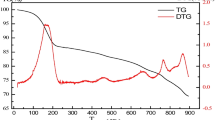Abstract
The feasibility of coordinated use of water-based drilling cuttings (WDC), fly ash, and phosphogypsum (PG) as raw materials for the preparation of WDC non-autoclaved aerated concrete (WNAAC) was evaluated by laboratory experiment. The results showed that the pozzolanic reaction of the multi-component cementitious system containing 40% (in mass) of WDC is significantly promoted. Newly formed C-S-H gel and ettringite with the uniform distribution of fibrous and flake-like shape occur, presenting a denser and interlock microstructure. In addition, after cured by steam at 80 °C for 24 h, the mechanical property and unit weight of the WNAAC prepared with 40% WDC fully meet the B06, A3.5 grade of China state standard (GB/T11968-2006). Environmental performance tests confirm that the WNAAC prepared with 40% WDC does not create any secondary contamination.


Similar content being viewed by others
References
Alam I, Ameen MA, Rehman F (2015) Partial replacement of cement by phosphogypsum in concrete. N Asian Int Res J Sci Eng I.T 1(2):1–11
Antemir A, Hills CD, Carey PJ, Magnie MC, Polettini A (2010) Investigation of 4-year-old stabilised/solidied and accelerated carbonated contaminated soil. J Hazard Mater 181:543–555
Chen Q, Zhang Q, Fourie A, Xin C (2017) Utilization of phosphogypsum and phosphate tailings for cemented paste backfill. J Environ Manag 201:19–27
Famy C, Brough AR, Taylor HFW (2003) The C-S-H gel of Portland cement mortars: Part I. The interpretation of energy-dispersive X-ray microanalyses from scanning electron microscopy, with some observations on C-S-H, AFm and AFt phase compositions. Cem Concr Res 33:1389–1398
Galvín AP, Agrela F, Ayuso J, Beltran MG, Barbudo A (2014) Leaching assessment of concrete made of recycled coarse aggregate: physical and environmental characterisation of aggregates and hardened concrete. Waste Manag 34:1693–1704
Garg M, Minocha AK, Jain N (2011) Environment hazard mitigation of waste gypsum and chalk: use in construction materials. Constr Build Mater 25:944–949
Huang Y, Lu J, Chen F, Shui Z (2016) The chloride permeability of persulphated phosphogypsum-slag cement concrete. J Wuhan Univ Technol Mater Sci Ed:1031–1037. https://doi.org/10.1007/s11595-016-1486-5
Leonard SA, Stegemann JA (2010) Stabilization/solidification of petroleum drill cuttings: leaching studies. J Hazard Mater 174:484–491
Li XB, Zhou ZL, Zhao GY, Liu ZX (2008) Utilization of phosphogypsum for backfilling, way to relieve its environmental impact. Gospod Surowcami Min 24(4):225–232
Liu D-s, Wang C-q, Mei X-d, Zhang C (2018) Environmental performance, mechanical and microstructure analysis of non-fired bricks containing water-based drilling cuttings of shale gas. Constr Build Mater 183:215–225
Ma B, Lu W, Su Y, Li Y, Gao C, He X (2018) Synthesis of α-hemihydrate gypsum from cleaner phosphogypsum. J Clean Prod 195:396–405
Mun KJ, Hyoung WK, Lee CW, So SY, Soh YS (2007) Basic properties of non-sintering cement using phosphogypsum and waste lime as activator. Constr Build Mater 21:1342–1350
Nigade S, Bagade M (2015) An experimental investigation of partial replacement of cement by various percentage of phosphogypsum in cement concrete with different water cement ratio. Int J Innov Sci Eng Technol 2(3):347–349
Shen W, Gan G, Dong R, Chen H, Tan Y, Zhou M (2012) Utilization of solidified phosphogypsum as Portland cement retarder. J Mater Cycles Waste Manag 14:228–233
Shen Y, Qian J, Chai J, Fan Y (2014) Calcium sulphoaluminate cements mad with phosphogypsum: production issues and material properties. Cem Concr Compos 48:67–74
Sheng Z, Zhou J, Zhu S, Yakubu Y, Chen Y, Wang W (2018) Calcium sulfate whisker reinforced non-fired ceramic tiles prepared from phosphogypsum. Bol Soc Española Cerámica Vidrio 57:73–78
Taher MA (2007) Influence of thermally treated phosphogypsum on the properties of Portland slag cement. Resour Conserv Recycl 52:28–38
Taylor HFW (1986) Proposed structure for calcium silicate hydrates gel. J Eur Ceram Soc 69:464–467
Türkel S, Aksin E (2012) A comparative study on the use of fly ash and phosphogypsum in the brick production. Indian Acad Sci Sādhanā 37(5):595–607
Wang XM, Zhao B, Zhang QL (2009) Cemented backfill technology based on phosphorous gypsum. J Cent South Univ T 16(2):285–291
Wang C-q, Lin X-y, Zhang C, Mei X-D (2017) Environmental security control of resource utilization of shale gas’ drilling cuttings containing heavy metals. Environ Sci Pollut Res 24(27):21973–21983
Yang L, Zhang Y, Yan Y (2016) Utilization of original phosphogypsum as raw material for the preparation of self-leveling mortar. J Clean Prod 127:204–213
Zhou J, Yu D, Shu Z, Li T, Chen Y, Wang Y (2014) A novel two-step hydration process of preparing cement-free non-fired bricks from waste phosphogypsum. Constr Build Mater Constr Build Mater 73:222–228
Author information
Authors and Affiliations
Corresponding author
Additional information
Responsible Editor: Philippe Garrigues
Publisher’s note
Springer Nature remains neutral with regard to jurisdictional claims in published maps and institutional affiliations.
Rights and permissions
About this article
Cite this article
Wang, Cq., Mei, Xd., Zhang, C. et al. Mechanism study on co-processing of water-based drilling cuttings and phosphogypsum in non-autoclaved aerated concrete. Environ Sci Pollut Res 27, 23364–23368 (2020). https://doi.org/10.1007/s11356-020-09029-z
Received:
Accepted:
Published:
Issue Date:
DOI: https://doi.org/10.1007/s11356-020-09029-z




